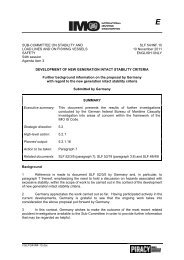Examination of the intact stability and the seakeeping behaviour
Examination of the intact stability and the seakeeping behaviour
Examination of the intact stability and the seakeeping behaviour
Create successful ePaper yourself
Turn your PDF publications into a flip-book with our unique Google optimized e-Paper software.
3.6 Free surface correction<br />
3.6 Free surface correction<br />
When tanks are partly lled in a loading condition, <strong>the</strong> free surface <strong>of</strong> <strong>the</strong> containing uid<br />
inuences <strong>the</strong> <strong>stability</strong> <strong>of</strong> <strong>the</strong> ship. The liquid's center <strong>of</strong> gravity moves when <strong>the</strong> ship heels.<br />
This leads to an apparent reduction <strong>of</strong> <strong>the</strong> GM. The corrected GM is usually determined by<br />
<strong>the</strong> formula 3.1 shown below<br />
GM corrected = GM solid − ∑ i<br />
ρ liquid i · I tank i<br />
△<br />
(3.1)<br />
for each partly lled tank i with <strong>the</strong> particular density <strong>of</strong> <strong>the</strong> liquid in tank ρ liquid , <strong>the</strong> particular<br />
moment <strong>of</strong> inertia <strong>of</strong> <strong>the</strong> free surface I tank <strong>and</strong> <strong>the</strong> displacement △ belonging to <strong>the</strong> particular<br />
loading condition .<br />
For <strong>the</strong> quasi-static <strong>intact</strong> <strong>stability</strong> analysis, this procedure is permissible. But for <strong>the</strong> highly<br />
nonlinear motions <strong>of</strong> a ship in seaways <strong>the</strong> correction is inaccurate, because <strong>the</strong> damping eect<br />
<strong>of</strong> <strong>the</strong> sloshing uid in <strong>the</strong> tank is not considered. For example this eect is used intentionally<br />
in roll damping tanks.<br />
For <strong>the</strong> <strong>seakeeping</strong> calculations it has been gured out, that both eects (roll damping due to<br />
sloshing <strong>and</strong> <strong>stability</strong> reduction due to <strong>the</strong> free surface) approximately compensate each o<strong>the</strong>r.<br />
Therefore <strong>the</strong> <strong>seakeeping</strong> calculations in E4 are always performed with an uncorrected GM solid .<br />
3.7 Intact <strong>stability</strong><br />
The <strong>intact</strong> <strong>stability</strong> is calculated according to <strong>the</strong> <strong>intact</strong> <strong>stability</strong> code <strong>of</strong> <strong>the</strong> IMO [4]. It is<br />
performed to determine <strong>the</strong> limiting <strong>intact</strong> <strong>stability</strong> criterion in <strong>the</strong> examined ballast arrival<br />
loading condition. The following six criteria are considered:<br />
1. The initial metacentric height GM 0 (including free surfaces) shall not be less than 0.15 m.<br />
(named in <strong>the</strong> following: Initial GM is 0.15 m)<br />
2. The righting lever GZ shall be at least 0.2 m at an angle <strong>of</strong> heel equal to or greater than<br />
30 ◦ . (named in <strong>the</strong> following: GZ is 0.2 at 30 ◦ )<br />
3. The maximum righting lever shall occur at an angle <strong>of</strong> heel not less than 25 ◦ . (named in<br />
<strong>the</strong> following: Max. GZ at 25 ◦ )<br />
4. The area under <strong>the</strong> GZ curve shall not be less than 0.055 metre − radians up to 30 ◦ angle<br />
<strong>of</strong> heel. (named in <strong>the</strong> following: Area (0, 30) = 0.055 m · rad)<br />
5. The area under <strong>the</strong> GZ curve shall not be less than0.09 metre − radians up to 40 ◦ angle<br />
<strong>of</strong> heel. (named in <strong>the</strong> following: Area (0, 40) = 0.090 m · rad)<br />
6. The area under <strong>the</strong> GZ curve between <strong>the</strong> angles <strong>of</strong> heel <strong>of</strong> 30 ◦ <strong>and</strong> 40 ◦ shall not be less<br />
than 0.03 metre − radians. (named in <strong>the</strong> following: Area (30, 40) = 0.030 m · rad)<br />
3.8 Cross-curves <strong>of</strong> <strong>stability</strong><br />
Fur<strong>the</strong>rmore <strong>the</strong> cross-curves <strong>of</strong> <strong>stability</strong> <strong>of</strong> <strong>the</strong> hull for xed <strong>and</strong> free trim are calculated. The<br />
resulting curves in E4 are compared to <strong>the</strong> curves derived from <strong>the</strong> <strong>stability</strong> booklet. The better<br />
<strong>the</strong> curves match, <strong>the</strong> better <strong>the</strong> E4 calculation model matches <strong>the</strong> calculating model <strong>of</strong> <strong>the</strong><br />
shipyard. Thereby its assured, that <strong>the</strong> result <strong>of</strong> <strong>the</strong> calculations are applicable to <strong>the</strong> realized<br />
vessel.<br />
15

















